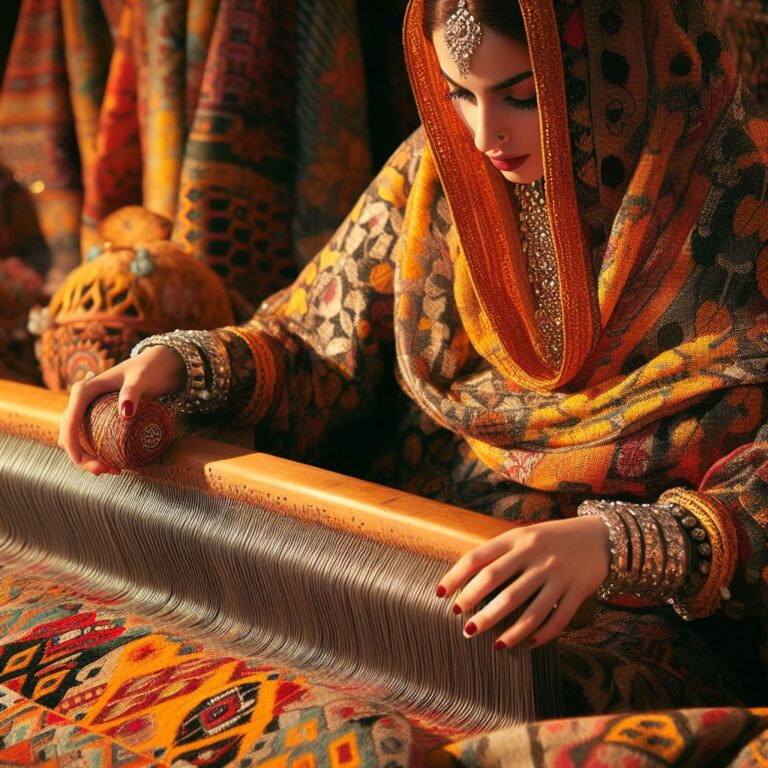Pashmina Perfection: The Art and Legacy of Ladakh Pashmina Weaving
Nestled within the majestic landscapes of the Himalayas, Ladakh, often referred to as the “Land of High Passes,” is not only renowned for its breathtaking scenery but also for its rich cultural heritage, including the art of Pashmina weaving.
Pashmina, also known as cashmere wool, is derived from the soft undercoat of the Changthangi goats, indigenous to the region.
In this article, we explore the intricate art of Ladakh Pashmina weaving, delving into its history, techniques, and the unparalleled luxury it brings to the world of textiles.
Table of Contents
Historical Roots and Cultural Significance
Ladakh’s Pashmina weaving tradition dates back centuries, with the craft being an integral part of the region’s cultural heritage.
Historically, Pashmina was a symbol of royalty and wealth, coveted by emperors and nobles for its unparalleled softness and warmth.
Over time, the art of Pashmina weaving has been passed down through generations, preserving its authenticity and craftsmanship.
Materials and Techniques
The heart of Ladakh Pashmina weaving lies in the meticulous sourcing of the raw material and the skilled techniques employed by local artisans.
The Changthangi goats, found in the high-altitude regions of Ladakh, provide the fine, downy fleece essential for weaving Pashmina shawls.
The wool is meticulously cleaned, spun, and dyed using natural pigments derived from plants and minerals.
The weaving process involves traditional handlooms, where skilled artisans intricately interlace the threads to create the luxurious Pashmina fabric.
Intricate Designs and Patterns
Ladakh Pashmina weaving is distinguished by its intricate designs and patterns, inspired by the region’s natural beauty and cultural motifs.
Artisans skillfully incorporate traditional Ladakhi symbols, such as stylized lotus flowers, snow lions, and auspicious symbols, into their creations.
These designs are meticulously woven, resulting in shawls and scarves that are not just garments but pieces of art, reflecting the rich heritage of Ladakh.
Luxurious Appeal and Global Recognition
Ladakh Pashmina products are synonymous with luxury and elegance. The softness and warmth of these shawls, combined with their exquisite designs, have earned them a revered status in the world of fashion.
Renowned designers and discerning customers alike appreciate the unparalleled quality and craftsmanship of Ladakh Pashmina, making it a coveted accessory across the globe.
Preservation of the Craft and Sustainable Practices
Efforts are underway to preserve the Ladakh Pashmina weaving tradition and promote sustainable practices.
Local cooperatives and organizations work closely with artisans, providing training, ensuring fair wages, and promoting eco-friendly dyeing techniques.
These initiatives not only support the livelihoods of the weavers but also contribute to the conservation of the fragile Himalayan ecosystem.
Ladakh Pashmina weaving represents more than just a craft; it embodies the spirit of a resilient and culturally rich community.
The delicate balance between tradition and innovation, coupled with the unmatched quality of the material and the artistry of the weavers, elevates Ladakh Pashmina to the pinnacle of luxury textiles.
As the world embraces sustainable fashion and heritage crafts, Ladakh Pashmina weaving stands as a shining example of timeless elegance and cultural pride, weaving together the threads of tradition and luxury for generations to come.
how to learn Pashmina Weaving
Learning Pashmina weaving, an ancient and intricate craft, requires dedication, patience, and hands-on experience.
Here’s a step-by-step guide to help you get started with learning Pashmina weaving:
1. Understand the History and Significance:
- Familiarize yourself with the history, origin, and cultural significance of Pashmina weaving. Understanding the heritage behind the craft will deepen your appreciation for it.
2. Study Pashmina Fibers and Materials:
- Learn about the types of wool used in Pashmina weaving, especially the fine fibers from Pashmina goats. Understand the characteristics of these fibers and how they contribute to the quality of the final product.
3. Find a Skilled Mentor or Take Classes:
- Look for experienced Pashmina weavers or weaving schools where you can receive hands-on training. Learning directly from a skilled mentor or attending workshops can provide invaluable insights and practical knowledge.
4. Master the Basics of Weaving:
- If you’re new to weaving, start by mastering the fundamental weaving techniques. Understand concepts like warp and weft, different types of looms, and basic weaving patterns.
5. Practice on Simple Looms:
- Begin practicing on simple handlooms to hone your weaving skills. Familiarize yourself with the various tools used in weaving, such as shuttles, heddles, and reeds.
6. Learn Traditional Pashmina Weaving Patterns:
- Study traditional Pashmina weaving patterns and motifs. These patterns often have cultural significance and are passed down through generations. Practice replicating these patterns to enhance your skills.
7. Experiment with Colors and Designs:
- Once you have a good grasp of the basics, experiment with different colors, designs, and patterns. Creativity is key in weaving, so don’t be afraid to innovate and create your unique styles.
8. Develop Patience and Attention to Detail:
- Pashmina weaving demands precision and attention to detail. Develop patience and focus on producing high-quality, finely woven fabric. Attention to detail is what sets exceptional Pashmina products apart.
9. Document Your Progress:
- Keep a weaving journal or portfolio where you document your projects, techniques used, challenges faced, and lessons learned. This documentation can serve as a reference for future projects and showcase your progress.
10. Join Weaving Communities:
- Connect with weaving communities, both online and offline, where you can interact with fellow weavers. Engaging with a community provides opportunities for learning, sharing experiences, and receiving feedback on your work.
11. Visit Pashmina Workshops and Markets:
- If possible, visit regions known for Pashmina production, such as Ladakh in India. Touring workshops and observing skilled weavers at work can be incredibly inspiring and educational.
12. Practice Regularly and Seek Feedback:
- Dedicate regular time to practice weaving. Don’t shy away from seeking feedback from experienced weavers or mentors. Constructive criticism can help you refine your techniques and improve your craft.
Remember, Pashmina weaving is a nuanced art form that takes years to master. Stay dedicated, practice consistently, and continuously seek knowledge to become proficient in this intricate and beautiful craft.


0 Comments